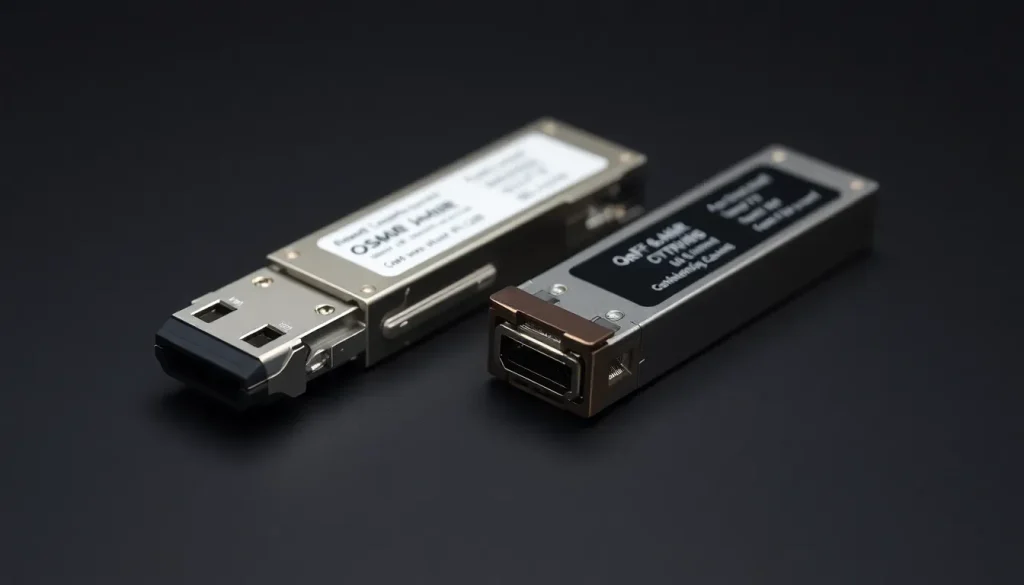QSFP vs QSFP-DD: Key Differences Explained

In the rapidly evolving world of networking technology, understanding the distinctions between different optical modules is crucial for making informed decisions. As we transition towards higher bandwidth requirements, especially with the emergence of 400G and beyond, the differences among various modules become increasingly significant. This article delves into the key differences between QSFP and QSFP-DD modules, shedding light on their functionalities, compatibility, and practical applications.
At a glance, the most noticeable difference between QSFP and QSFP-DD modules lies in their electrical connectivity. As networking demands escalate, the design of these modules has adapted to accommodate greater speeds and bandwidths, leading to a more intricate landscape of optical technologies.
- Understanding the Basics of QSFP and QSFP-DD
- Key Differences in Electrical Connectivity
- Backward Compatibility Explained
- Exploring the Compatibility Landscape
- Comparative Analysis of Module Generations
- Common Use Cases for QSFP and QSFP-DD Modules
- Choosing Between QSFP and QSFP-DD
- Final Thoughts on Module Evolution
Understanding the Basics of QSFP and QSFP-DD
Before venturing into the specifics, it's essential to grasp what QSFP and QSFP-DD stand for. QSFP, or Quad Small Form-factor Pluggable, represents a standard for high-speed network connections, capable of supporting various data rates. On the other hand, QSFP-DD, or Quad Small Form-factor Pluggable Double Density, is an enhanced version designed to double the number of electrical lanes, facilitating higher data throughput.
The QSFP28 module is a prominent example, utilizing four lanes with a capacity of 25G each, resulting in a total bandwidth of 100Gbps. Conversely, the QSFP56 module offers a more robust solution, with each lane capable of 50G, thus achieving a combined throughput of 200Gbps.
Key Differences in Electrical Connectivity
One of the most significant advancements in the QSFP-DD technology is its ability to support eight electrical lanes, effectively doubling the data capacity. This increase is made possible by the additional row of connection pads present in the QSFP-DD design. The implications of this change are particularly relevant when considering the transition to 400G optical networks.
- QSFP28: 4x 25G lanes = 100Gbps
- QSFP56: 4x 50G lanes = 200Gbps
- QSFP-DD: 8x 50G lanes = 400Gbps
- QSFP28-DD: 8x 25G lanes = 200Gbps
- QSFP112: 8x 112G lanes = 800Gbps
This architectural change enables the QSFP-DD modules to meet the escalating demands for bandwidth in modern data centers and high-performance computing environments. In contrast, traditional QSFP modules, while still relevant, may not suffice for the most recent requirements.
Backward Compatibility Explained
A critical consideration when transitioning to newer technologies is backward compatibility. The QSFP-DD was engineered with this in mind, allowing it to accommodate existing QSFP devices. Users can confidently plug their QSFP modules into QSFP-DD cages, ensuring functionality without needing to replace their entire infrastructure. However, this compatibility is not reciprocal; connecting a QSFP-DD module to a QSFP cage will not work due to the additional connections and the longer connector of the QSFP-DD.
Exploring the Compatibility Landscape
Beyond the backward compatibility features, it's essential to understand the wider implications of using different types of modules in various network configurations. The following points outline the compatibility and operational aspects:
- **QSFP28 and QSFP56**: Both can operate efficiently in environments designed for QSFP-DD, making upgrades less disruptive.
- **QSFP-DD modules**: Their capability to handle higher data rates means they can easily integrate into systems that were initially built around QSFP standards.
- **Future-proofing**: Investing in QSFP-DD technology may provide a longer operational lifespan as network demands increase.
Comparative Analysis of Module Generations
As the industry progresses, comparing the various generations of modules becomes vital for understanding their applications:
| Module Type | Data Rate per Lane | Total Bandwidth | Backward Compatibility |
|---|---|---|---|
| QSFP+ | 10G | 40Gbps | Limited |
| QSFP28 | 25G | 100Gbps | Partially |
| QSFP56 | 50G | 200Gbps | Partially |
| QSFP-DD | 50G / 100G | 400Gbps | YES |
This comparative analysis highlights the evolution of optical modules, illustrating how advancements in technology continue to shape their functionalities and interoperability.
Common Use Cases for QSFP and QSFP-DD Modules
The deployment of QSFP and QSFP-DD modules varies depending on specific requirements across different sectors. Here are some common use cases:
- Data Centers: Both modules are prevalent in modern data centers, with QSFP-DD being favored for high-bandwidth applications.
- Telecommunications: The flexibility and speed of these modules support the backbone of telecommunications infrastructure.
- High-Performance Computing: Environments that require rapid data processing benefit significantly from the capabilities of QSFP-DD.
Choosing Between QSFP and QSFP-DD
When deciding which module to implement, several factors should be considered:
- Bandwidth Requirements: Assess whether your applications demand the higher speeds offered by QSFP-DD.
- Infrastructure Longevity: Evaluate how future-proof your infrastructure needs to be as bandwidth demands grow.
- Cost Considerations: Factor in the total cost of ownership, including potential future upgrades.
Ultimately, the choice between QSFP and QSFP-DD should align with your specific business goals and technological requirements.
Final Thoughts on Module Evolution
In the world of optical modules, understanding the nuances between different generations is crucial for making informed decisions. With the ongoing evolution of data transmission technologies, keeping abreast of these changes ensures that businesses can effectively manage their networking needs. As you explore your options, consider the form factor, electrical connectivity, and optical configurations that best fit your operational requirements.
For more insights into the differences between QSFP and QSFP-DD, check out this informative video:




Leave a Reply